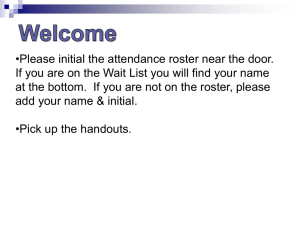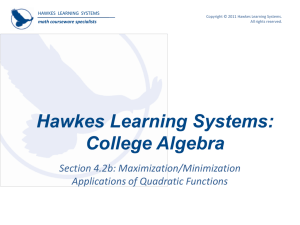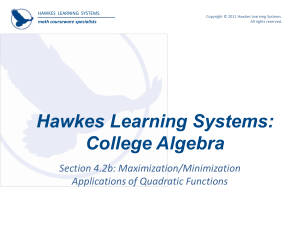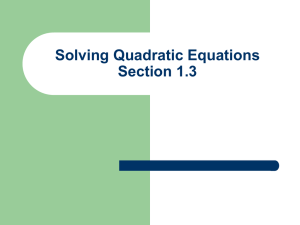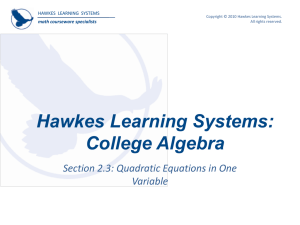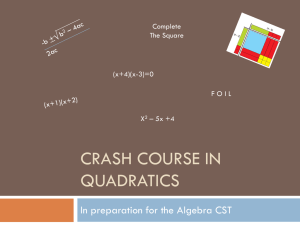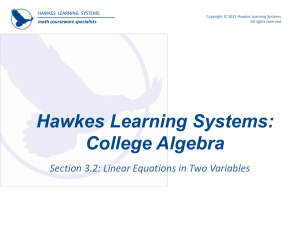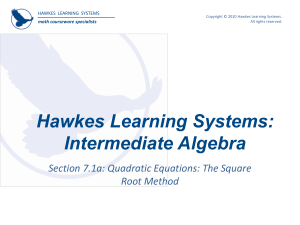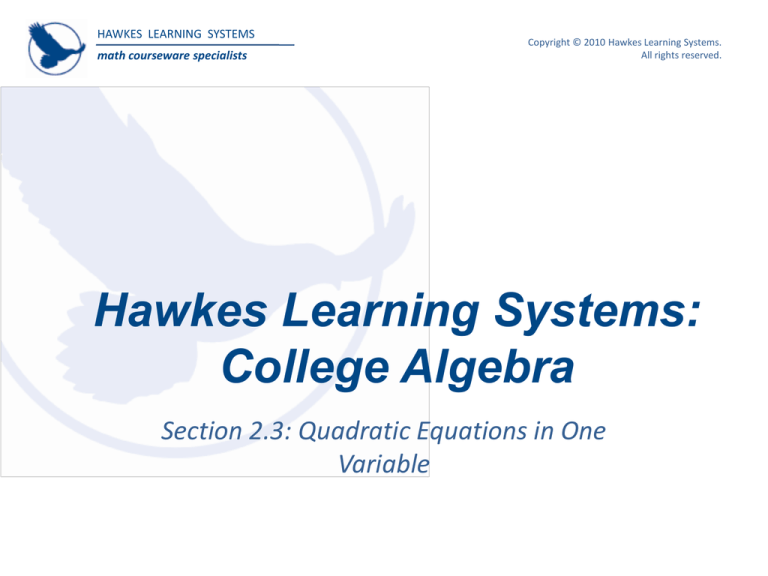
HAWKES LEARNING SYSTEMS
math courseware specialists
Copyright © 2010 Hawkes Learning Systems.
All rights reserved.
Hawkes Learning Systems:
College Algebra
Section 2.3: Quadratic Equations in One
Variable
HAWKES LEARNING SYSTEMS
Copyright © 2010 Hawkes Learning Systems.
All rights reserved.
math courseware specialists
Objectives
o Solving quadratic equations by factoring.
o Solving “perfect square” quadratic equations.
o Solving quadratic equations by completing the
square.
o The quadratic formula.
o Applications: gravity problems.
HAWKES LEARNING SYSTEMS
Copyright © 2010 Hawkes Learning Systems.
All rights reserved.
math courseware specialists
Quadratic Equations
A quadratic equation in one variable, say the variable
x is an equation that can be transformed into the form
ax 2 bx c 0
Where a , b , and c are real numbers and a 0 . Such
equations are also called second-degree equations, as
x appears to the second power. The name quadratic
comes from the Latin word quadrus, meaning
“square”.
HAWKES LEARNING SYSTEMS
Copyright © 2010 Hawkes Learning Systems.
All rights reserved.
math courseware specialists
Solving Quadratic Equations by Factoring
Zero –Factor Property
Let A and B represent algebraic expressions. If
the product of A and B is 0, then at least one of
A and B itself is 0 . That is,
AB 0 A 0 or B 0
For example,
x x 1 0 x 0 or
x 1 0
HAWKES LEARNING SYSTEMS
math courseware specialists
Copyright © 2010 Hawkes Learning Systems.
All rights reserved.
Solving Quadratic Equations by Factoring
o The key to using factoring to solve a quadratic
equation is to rewrite the equation so that 0 appears
by itself on one side of the equation.
2
ax
bx c can be factored, it can be
o If the trinomial
written as a product of two linear factors A and B .
o The Zero-Factor Property then implies that the only
way for ax 2 bx c to be 0 is if one (or both) of A
and B is 0.
HAWKES LEARNING SYSTEMS
Copyright © 2010 Hawkes Learning Systems.
All rights reserved.
math courseware specialists
Example: Solving Quadratic Equations by
Factoring
Solve the quadratic equation by factoring.
3x 2
x
5 5
2
Step 1: Multiply both
sides by 5 .
Step 2: Subtract 2 from
both sides so 0 is
on one side.
Step 3: Factor and solve the
two linear equations.
5 x 2 3x 2
5 x 2 3x 2 0
(5x 2)( x 1) 0
5x 2 0
or
2
x
or
5
x 1 0
x 1
HAWKES LEARNING SYSTEMS
Copyright © 2010 Hawkes Learning Systems.
All rights reserved.
math courseware specialists
Example: Solving Quadratic Equations by
Factoring
Solve the quadratic equation by factoring.
x 2 16 8 x
x 2 8 x 16 0
x 4
x40
2
0
or
x40
x4
In this example, the two linear factors are the same. In
such cases, the single solution is called a double solution
or a double root.
HAWKES LEARNING SYSTEMS
Copyright © 2010 Hawkes Learning Systems.
All rights reserved.
math courseware specialists
Example: Solving Quadratic Equations by
Factoring
Solve the quadratic equation by factoring.
6 x 2 18 x 0
6 x( x 3) 0
6x 0
x0
or
or
x3 0
x 3
HAWKES LEARNING SYSTEMS
Copyright © 2010 Hawkes Learning Systems.
All rights reserved.
math courseware specialists
Solving “Perfect Square” Quadratic Equations
In some cases where the factoring method is
unsuitable, the solution to a second-degree polynomial
can be obtained by using our knowledge of square
roots.
If A is an algebraic expression and if c is a constant:
A c implies A c
2
If a given quadratic equation can be written in the
2
form A c we can use the above observation to
obtain two linear equations that can be easily solved.
HAWKES LEARNING SYSTEMS
math courseware specialists
Copyright © 2010 Hawkes Learning Systems.
All rights reserved.
Example: Square Root Method
Solve the quadratic equation using the Square Root
Method.
a)
x2 = 25
b)
6x2 = 54
HAWKES LEARNING SYSTEMS
math courseware specialists
Copyright © 2010 Hawkes Learning Systems.
All rights reserved.
Example: “Perfect Square” Quadratic Equations
Solve the quadratic equation by taking square roots.
(5x 2)2 3
Step 1: Take the square root
of each side.
Step 2: Subtract 2 from
both sides.
Step 3: Divide both sides by
5.
5x 2 3
5 x 2 3
2 3
x
5
HAWKES LEARNING SYSTEMS
Copyright © 2010 Hawkes Learning Systems.
All rights reserved.
math courseware specialists
Example: “Perfect Square” Quadratic Equations
Solve the quadratic equation by taking square roots.
x 7
2
25 0
x 7
2
25
x 7 25
x 7 5i
x 7 5i
In this example, taking square roots leads to two
complex number solutions.
HAWKES LEARNING SYSTEMS
math courseware specialists
Copyright © 2010 Hawkes Learning Systems.
All rights reserved.
Solving Quadratic Equations by Completing the
Square
Method of Completing the Square
Step 1: Write the equation ax 2 bx c 0 in the form
2
ax bx c .
2
Step 2: Divide by a if a 1 , so the coefficient of x is 1 :
b
c
2
x x
a
a
Step 3: Divide the coefficient of x by 2 , square the
result, and add this to both sides.
Step 4: The trinomial on the left side will now be a
perfect square. That is, it can be written as the
square of an algebraic expression.
HAWKES LEARNING SYSTEMS
math courseware specialists
Copyright © 2010 Hawkes Learning Systems.
All rights reserved.
Example: Completing the Square
Solve the quadratic equation by completing the square.
2 x 2 8 x 10 0
Step 1: Move the constant
term to the other side
2 x 2 8 x 10
of the equation.
Step 2: Divide by 2 , the
x2 4 x 5
coefficient of x2
2
x
4x 4 5 4
Step
. 3: Add 4 to both sides.
Step 4: Factor the trinomial,
( x 2)2 9
and solve.
x 2 3
x 2 3
x 5, 1
HAWKES LEARNING SYSTEMS
math courseware specialists
Copyright © 2010 Hawkes Learning Systems.
All rights reserved.
The Quadratic Formula
The method of completing the square can be used to derive
the quadratic formula, a formula that gives the solution to
any equation of the form ax2 bx c 0.
Step 1: Move the constant to
the other side of the
equation.
Step 2: Divide by a .
b
Step 3: Divide a by 2
square the result, and
add it to both sides of
the equation.
ax2 bx c 0
ax2 bx c
x2
b
c
x
a
a
2
2
b
b
c
b
x2 x 2 2
a
4a
a 4a
HAWKES LEARNING SYSTEMS
math courseware specialists
Copyright © 2010 Hawkes Learning Systems.
All rights reserved.
The Quadratic Formula
Deriving the quadratic formula (cont.).
2
Step 4: Factor the
b
4ac b 2
trinomial, and
x 2 2
2a
4a
4a
solve for x .
2
2
b b 4ac
x
2
2
a
4
a
b
b 2 4ac
x
2a
2a
b b 2 4ac
x
2a
HAWKES LEARNING SYSTEMS
Copyright © 2010 Hawkes Learning Systems.
All rights reserved.
math courseware specialists
The Quadratic Formula
The solutions of the equation ax2 bx c 0 are:
b b2 4ac
x
2a
Note:
2
• The equation has 2 real solutions if b 4ac 0.
• The equation has 1 real solution if b2 4ac 0.
• The equation has 2 complex solutions (which are
conjugates of one another) if b2 4ac 0.
HAWKES LEARNING SYSTEMS
Copyright © 2010 Hawkes Learning Systems.
All rights reserved.
math courseware specialists
Example: The Quadratic Formula
Solve using the quadratic formula.
4 x2 7 x 15
c
a2 b
4x 7 x 15 0
b b2 4ac
x
2a
x
7
7 289
x
8
7 17
x
8
5
x 3,
4
7 4 4 15
2 4
2
HAWKES LEARNING SYSTEMS
Copyright © 2010 Hawkes Learning Systems.
All rights reserved.
math courseware specialists
Gravity Problems
o When an object near the surface of the Earth is
moving under the influence of gravity alone, its
height above the surface of the earth is described by
a quadratic polynomial in the variable t where t
stands for time and is usually measured in seconds.
o In some applications involving this formula, one of
the two solutions must be discarded as meaningless
in the given problem.
HAWKES LEARNING SYSTEMS
Copyright © 2010 Hawkes Learning Systems.
All rights reserved.
math courseware specialists
Gravity Problems
If we let h represent the height at time t ,
1 2
h gt v0t h0 ,
2
where g , v0 , and h0 are all constants:
• g = acceleration due to gravity (32 ft/sec2 or 9.8
m/sec2)
• v0 initial velocity
• h0 initial height
• t time, measured in seconds
HAWKES LEARNING SYSTEMS
Copyright © 2010 Hawkes Learning Systems.
All rights reserved.
math courseware specialists
Example: Gravity Problems
Luke stands on a tier of seats in a baseball stadium, and
throws a ball out onto the field with a vertical upward velocity
of 60 ft/s. The ball is 50 ft above the ground at the moment he
releases it. When does the ball land?
0 16t 2 60t 50
0 8t 2 30t 25
t
Since we know the
answer cannot be
negative, this
solution is discarded.
30
30
2
4 8 25
2 8
30 10 17
t
16
t 0.70,4.45

